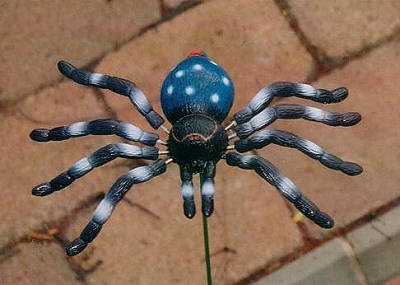This beautiful little wing mechanism making a playful kinetic ring is made by Dukno Yoon, a jeweller and metalsmith. There are other equally lovely ones operated by various small hand and wrist movements in his gallery. (via Colossal)
This beautiful little wing mechanism making a playful kinetic ring is made by Dukno Yoon, a jeweller and metalsmith. There are other equally lovely ones operated by various small hand and wrist movements in his gallery. (via Colossal)
The elephants in yesterday’s post reminded me of this big elephant trunk I made for The Flying Fruit Fly production, The Promise, in 2008. It was meant to wave out from behind some set element, implying the whole elephant was just behind. The mechanism was based on a tentacle mechanism I had worked out previously, but was more complicated because the control lines were too long for the see-saw lever and instead required spools to wind the lines onto alternately to take up the slack. In turn there was a lot of tension exerted on the spools, and the trunk weight added to that problem. So, not a perfect solution, but an interesting make.
I also thought this was nifty – wrinkly elephant skin made by painting latex on stretched lycra! This idea was suggested to me by Tim Denton, from AboutFace Productions, who did the major build for the show, and it worked brilliantly.
(enlarge)
Someone asked me how the movement of the Ningyo-Joruri puppet head that I made during Nori Sawa’s masterclass a few years ago worked , so I’ve drawn a diagram on my iPad to illustrate the mechanism. It makes more sense if you look at in context with my photoset from the class, and perhaps with the original blog post.
Tacky but interesting: this is a huge spider garden spike that I got at the $2 shop the other day. It’s a hand span across, and the connections between its legs and body are fine springs, so that when the spike is jolted the legs have an incidental movement. The best movement you can get out of it is a kind of drumming of the legs, where, on each side, legs 1 and 3 are in sync with each other, and legs 2 and 4 are doing the opposite. Then it has the right kind of action for a huntsman spider.

I have a couple of other insect garden spikes, a bee and a dragonfly (bought out of curiosity when I was working on making giant bees and dragonflies a few years ago). They are much smaller than the spider, with bodies about 7 cm long, and the wings are on double springs. The dragonfly has much lighter springs, and a much better incidental movement than the poor bee, whose springs and wings are way too heavy.
 Chomick & Meder is a wonderful site detailing the figurative art and automata of Peter Meder and Chris Chomick. Most of the figures are one-of-a-kind doll art, standing between 30 – 50 cm tall, and with heads, hands and feet sculpted from Cernit (something akin to Sculpy, maybe?). The figures are beautifully dressed, too. But its the odd and amusing characters that really draw me in. Take Elvisan, or Baby Dewey, or JouJou L’Amour for instance.
Chomick & Meder is a wonderful site detailing the figurative art and automata of Peter Meder and Chris Chomick. Most of the figures are one-of-a-kind doll art, standing between 30 – 50 cm tall, and with heads, hands and feet sculpted from Cernit (something akin to Sculpy, maybe?). The figures are beautifully dressed, too. But its the odd and amusing characters that really draw me in. Take Elvisan, or Baby Dewey, or JouJou L’Amour for instance.
A number of the figures have hand made automata mechanisms. These have been designed and machined by the artist, and consist of ‘an internal crankshaft, which enables the Automaton to operate at varied speed, in forward or reverse. The brass hand-crank mechanism operates a counterbalanced armature, creating a rhythmic side-to-side motion with alternating leg kicks’. In the automata gallery are three monkeys, Cecil and Emo, and the mad scientist Dr. Messmore, MD. With the last, the artist has been developing ‘a programmable automaton using servo electronics controlled by a laptop computer’ enabling ‘customized movements, essentially creating one-of-a-kind moving figurative sculptures’. Its described as an ongoing process, in which the ‘ultimate goal is to have the automaton operate independently of the computer, evolving from an educational tool to an art object desired by collectors of automata’.